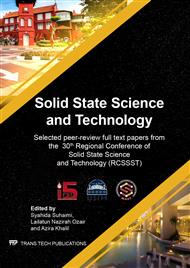[1]
B.N, and D.H, Review on synthesis, characterizations, and electrochemical properties of cathode materials for lithium ion batteries, J. Material Science & Eng. 5 (2016) 1-21.
Google Scholar
[2]
X. Li, Y. Xu and C. Wang, Suppression of Jahn-Teller distortion of spinel LiMn2O4 cathode, Journal of Alloys and Compounds. 6 (2002) 507-512.
DOI: 10.1016/j.jallcom.2008.12.081
Google Scholar
[3]
B. Scrosati, L. Sapienza and P.A Aldo, Recent advances in lithium ion battery materials, ElectrochimicaActa. 45 (2000) 2461-2466.
DOI: 10.1016/s0013-4686(00)00333-9
Google Scholar
[4]
J. Huang, F. Yang, Y. Guo, C. Peng, H. Bai, J. Peng and J. Guo, LiMgxMn2-x (x ≤ 0.10) cathode materials with high rate performance prepared by molten-salt combustion at low temperature, Ceramics International. 41 (2005) 9662-9667.
DOI: 10.1016/j.ceramint.2015.04.032
Google Scholar
[5]
W. Xu, H. Bai, Q. Li, T. Feng, J. Guo, L. Feng, C. Su, W. Bai and X. Liu, Preparation and electrochemical performance of nano-LiNi0.05Mn1.95O4 cathode materials by a low temperature molten-salt combustion method, International Journal of Electrochemical Science. 12 (2017) 9758-9773.
DOI: 10.20964/2017.10.11
Google Scholar
[6]
S. Jayapal, R. Mariappan, S. Sundar and S. Piraman, Electrochemical behavior of LiMn2-X-YTixFeYO4 as cathode material for Lithium ion batteries, Journal of Electroanalytical Chemistry. 720-721 (2014) 58-63.
DOI: 10.1016/j.jelechem.2014.03.016
Google Scholar
[7]
N.F. Yahya, N. Kamarulzaman, K. Elong, N.A.M. Mokhtar, A.F.M. Fadzil, N.H. Zainol, A. Azahidi, Synthesis of LiMn1.9Ti0.1O4,, AIP Conference Proceedings. Volume 1877 (2017), p.040008.
DOI: 10.1063/1.4999874
Google Scholar
[8]
N. Kamarulzaman, N. Kamarudin, R. Rusdi, K. Elong, M.H. Jaafar, Synthesis and Electrochemical Behaviour of Lithium Manganese Vanadates,, Advanced Materials Research, Vol. 545 (2012) pp.195-198.
DOI: 10.4028/www.scientific.net/amr.545.195
Google Scholar
[9]
A.A. Rahman, R. Rusdi, K. Elong and N. Kamarulzaman, Synthesis and Electrochemical Behaviour of LiMn(2-x)ZnxO4 Cathode Materials,, Advanced Materials Research, Vol. 545 (2012) pp.199-203.
DOI: 10.4028/www.scientific.net/amr.545.199
Google Scholar
[10]
K. Elong, N. Kamarulzaman, R. Rusli, N. Badar, M.H. Jaafar, Solid Solutions of LiCo1-xNixO2 (x=0,0.1,…,0.9) Obtained via a Combustion Synthesis Route and Their Electrochemical Characteristics. ISRN Condensed Matter Physics, Vol. 2013 (2013) 2.
Google Scholar


